Achieving ZEB with Efficient Air Conditioning
Environmental Measures in Construction
- Power-saving
- Visualization
- Operational-efficiency
- Improve-service
- Building
Air conditioning accounts for a large proportion of buildings’ energy consumption, and measures targeting the entrances to buildings are attracting particular attention.
Negative effect of Automatic Doors
Many shops, as well as facilities such as hospitals and train stations, have automatic doors. They are convenient, and are an absolute must for smooth movement of people, but in crowded areas there is the problem of unnecessary opening, wherein automatic doors can continually remain open in places where there is heavy human traffic or where the area around the doors can be easily congested, and when these doors open and close unintentionally in response to people passing in front of them. So, what kind of problems does unnecessary opening create for building owners, superintendents, and us as general users of automatic doors?
Building owners
• The monthly electricity bills are increased.
Building administrators
• Air comes in from outside, defeating the purpose of the air conditioning.
• Sanitation can’t be maintained.
Users
• The door opens even if you’re not going inside, and the door stays open if you’re waiting in line.
• Noise from outside is annoying.
These are all actual concerns that the concerned parties have expressed.
Some people may say “But what about the kind of automatic doors that open when you push a switch?” Those people certainly have a point. But isn’t the main goal of automatic doors meant to be to open and close smoothly and comfortably at all times, allowing passers through to do so in comfort? The button-type automatic doors force people to stand and wait for a moment before they open, and are not a real barrier-free solution for wheelchair-bound individuals.
In places like New York and South Korea, there are legal restrictions in place so as to prevent businesses directly facing the street from leaving their doors open with the air conditioning on. Because the air conditioning is wasted and this has a direct impact on the electricity bills, it is a problem that, from a building management point of view, cannot be taken lightly.
Automatic door sensors cut down on unnecessary opening of automatic doors, not only saving on buildings’ energy consumption, but causing the doors to open at the optimal time for the door users without them even realizing it. This greatly contributes to making ZEBs a reality.
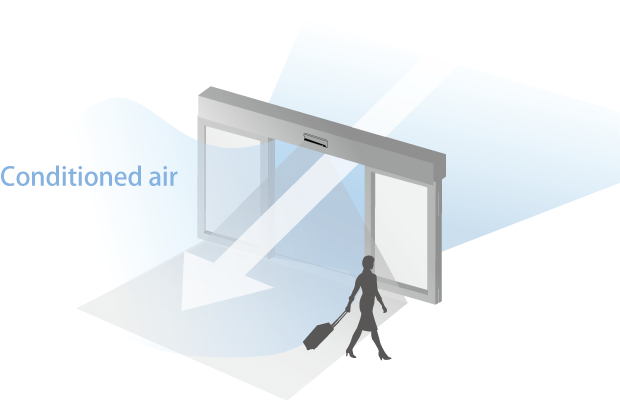
How we contribute to achieve ZEB
The energy loss of a building is considered to be affected by four factors: heat transfer, air leakage, air outflow, and power consumption.Above all, “air outflow” accounts for more than six times the loss compared to other factors, so we can say with confidence that reducing this air outflow is a shortcut to energy loss reduction.
Of the “energy consumption in the entire building,” air conditioning accounts for at least 50% in offices and 40% in stores and hotels, surpassing both lighting and hot water to become the top drain on energy. Knowing this, it becomes clear that effective air conditioning energy saving measures are the key to unlocking ZEB construction. (*1)
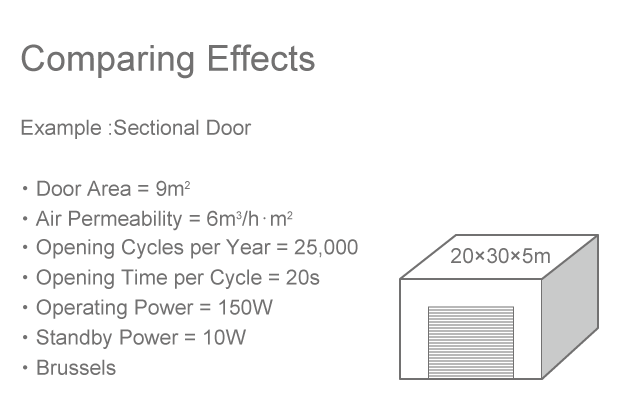
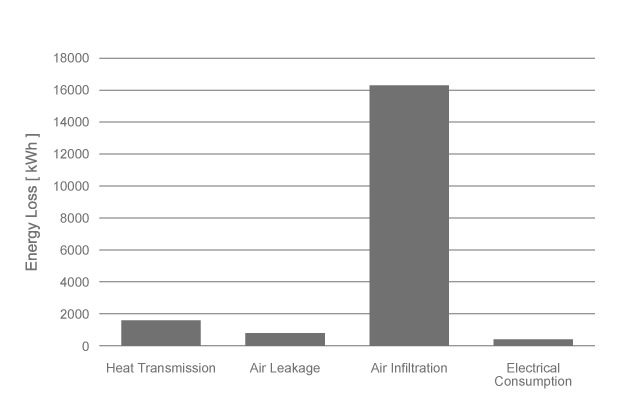
Graph(*2)
Up until now, it has been difficult, from a safety perspective, to adopt the strategy of shortening the opening time of doors for the purpose of reducing air leakage.
By mounting a camera onto the near infrared ray automatic door sensor, the “VVS-1” can read the speed and direction of pedestrians, causing the door to open at the optimal time for the person’s movement speed, and allowing for the door to remain shut if the people are just passing by rather than going inside. The near infrared ray sensor detects a person’s presence and sends the order for the door to open, while the camera is used to retrieve information on the movement direction of the person and recognize other behavior of the person.
A. Detection Area
The system recognizes the presence of people in this area.
B. e-Count Area
The system treats this area as the presence detection area just as with conventional automatic door sensors. Information obtained in this area is used to show the energy efficiency savings by comparing e-Smooth Sensor performance with that of conventional sensors.
C. Door Position Area
The system determines how wide to open the automatic doors.
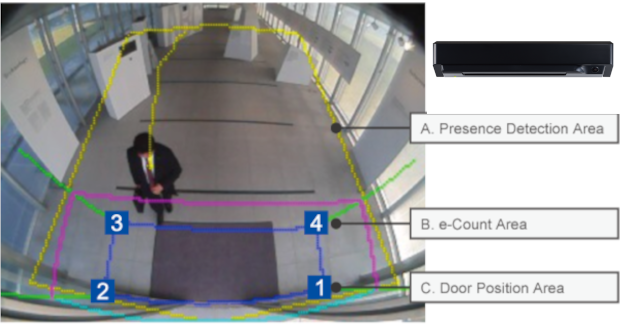
Area demarcation in the image-processing system
1: Individual Identification of Multiple Persons
Roughly 70 individuals can be recognized per second of footage. Small children, and even people with umbrellas or hats, can be detected.
2: Recognition of Movement Direction
Follows, in real time, the direction in which the people are moving. Detects only those individuals who are moving toward the automatic door. Cuts down on unnecessary opening for bystanders with no intention to pass through the automatic door.
3: Recognition of Movement Speed
Analyzes and predicts the movement speed of the person heading toward the automatic door. This allows the door to open at the appropriate time for each person.
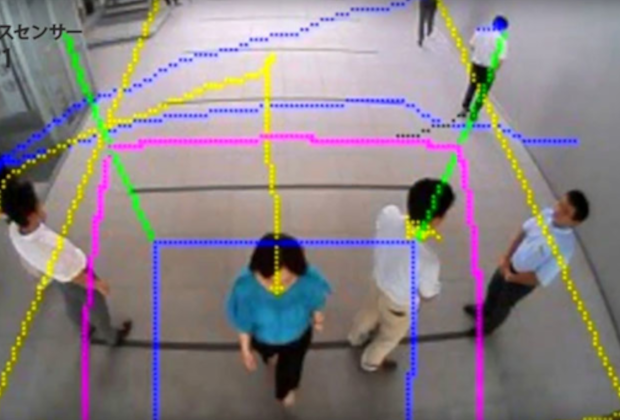
Cutting Down on Electricity by 30%
Because the e-Smooth Sensor allows you to control not only the time the door opens/closes but also the number of times it opens and closes, the more people who pass by the shop the more energy (and money!) you can save. It allows for a roughly 30%* decrease in the amount of electricity consumed when compared with traditional automatic door sensors! (*3)
In addition, it can contribute to improvement of the asset value of the building, by energy saving by the improvement of air conditioning efficiency through the reduction of “unnecessary opening,” reduction of the maintenance cost of the building, and further improvement of the users’ comfort.
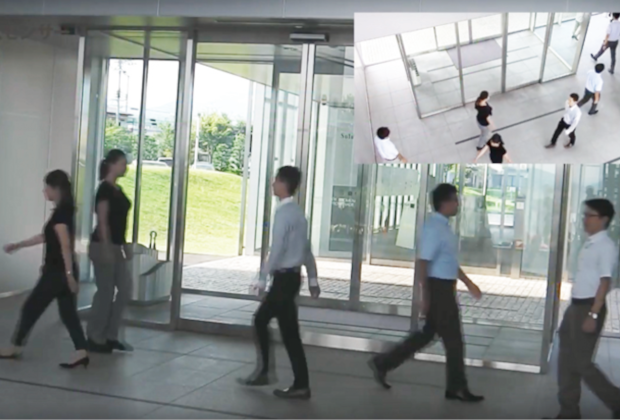
Effective Applications
- Public facilities and hospitals with an eye on an environmental society.
- Stores and office buildings with a large number of people passing by their automatic doors.
- Department stores, shopping centers, supermarkets, and restaurants, which have a large number of entrances in different places.
- Places such as convenience stores, ticket offices in train stations, other ticket vendors, etc., which, when busy, can experience long lines of people lined up near the door, causing it to remain open needlessly.
- High-traffic cafés looking out on the street, without windbreak rooms.
- Luxury brand stores and hotels aiming for a high level of hospitality.
- Commercial facilities, department stores, concert halls and so on, which have a large number of doors going out into hallways.
- Hospitals, public health facilities, stores selling food, and so on, where hygiene is especially important.
Notes
- 1. Source: METI (November 2009) “Report of the Convention on Research Relating to ZEB Realization and Development”
- 2. Graph: Building energy loss (Source: The European Door and Shutter Federation e.V.)
- 3. The calculation above is based on the application of this sensor’s “unnecessary opening” control results to the building energy loss calculation model put forth by CEN (the European Committee for Standardization, or Comité Européen de Normalisation in French).
(Reduction results will differ based on such factors as usage conditions and conditions at the site where the sensor is installed, etc.)
Reference Materials:
Contact phone number
- Headquarters
- +81-77-579-8700
Contact form
